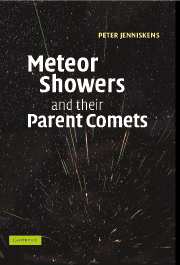Book contents
- Frontmatter
- Dedication
- Contents
- Preface
- Acknowledgements
- Part I Introduction
- Part II Parent bodies
- 6 Long-period comets
- 7 Halley-type comets
- 8 Jupiter-family comets
- 9 Fading comets of the inner Solar System
- 10 Asteroids as parent bodies of meteoroid streams
- Part III Young streams from water vapor drag
- Part IV Young streams from comet fragmentation
- Part V Old streams and sporadic meteoroids
- Part VI Impact and relevance of meteor showers
- Appendix
- Tables
- Index
- Units and constants
6 - Long-period comets
from Part II - Parent bodies
Published online by Cambridge University Press: 05 July 2015
- Frontmatter
- Dedication
- Contents
- Preface
- Acknowledgements
- Part I Introduction
- Part II Parent bodies
- 6 Long-period comets
- 7 Halley-type comets
- 8 Jupiter-family comets
- 9 Fading comets of the inner Solar System
- 10 Asteroids as parent bodies of meteoroid streams
- Part III Young streams from water vapor drag
- Part IV Young streams from comet fragmentation
- Part V Old streams and sporadic meteoroids
- Part VI Impact and relevance of meteor showers
- Appendix
- Tables
- Index
- Units and constants
Summary
Long-period comets arrived recently from cold storage in the Oort cloud. They are of particular interest because they can still have a high content of volatile ices, impact craters, and other mementos from the origin of the solar system. Their crust is not yet fallen-back debris, but not freshly exposed ice either. The crust has been irradiated by energetic cosmic rays in the past 4.55 billion years and is a potential source of unusual meteoroids.
The comet is called “long period” if P > 200 years or, more correctly, when its orbital evolution is not tightly controlled by the major planets. As I said there are some 1 trillion long-period comets (D > 1 km) in the Oort cloud. They have a magnitude distribution index: χc = N(H10 + 1)/N(H10) = 1.80, where H10 is the comet magnitude when located 1 AU from the Sun and 1 AU from Earth (the absolute magnitude). This corresponds to a mass distribution index of s = 1.64 ± 0.02. There is a conspicuous lack of comets smaller than about 3 km in size.
According to Bill Bottke and colleagues, about 415 long period comets with H10 < +16.8m (D > 0.2 km) cross Earth's orbit each year (strictly having q < 1.05 AU), whereby ten are brighter than H10 < 11m (D > 1 km). The impact rate on Earth is about once per 150 million years for long period comets larger than 1 km in size.
Jan Oort calculated that most “new” comets return to their perihelion only once every 4 million years. The average of all observed comets is about once every 100 000 years, on account of the intermediate long-period comets (P = 200–10 000 yr), abbreviated as “ILPCs,” which are more efficiently detected on account of their more frequent visits.
There are far fewer comets in intermediary orbits than expected (Fig. 6.1). This mystery is called the fading problem.
- Type
- Chapter
- Information
- Meteor Showers and their Parent Comets , pp. 71 - 87Publisher: Cambridge University PressPrint publication year: 2006



